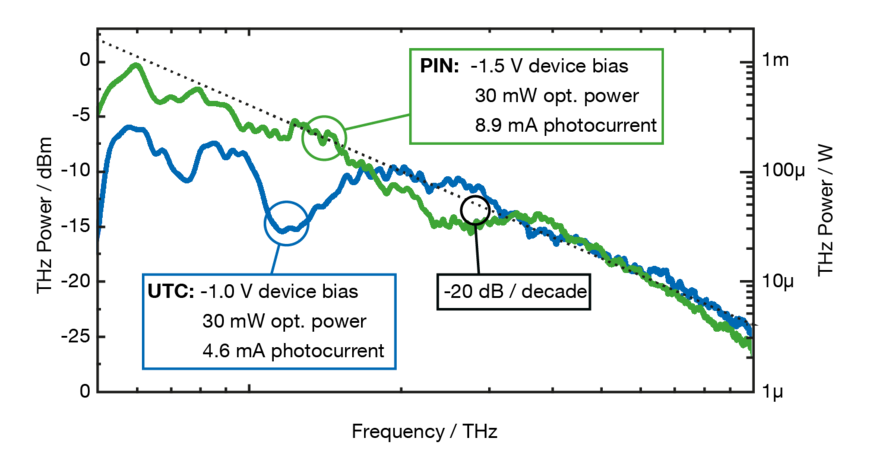Calibrated Output Power Measurements of
cw-Terahertz Emitters
Optoelectronic continuous-wave (cw) terahertz systems have been gaining increasing attention, both for applications in high-resolution spectroscopy, and for research towards high-speed wireless communication. In both fields, the absolute power produced by the emitter is one of the most crucial parameters, yet has proven difficult to measure accurately. In a carefully designed series of experiments, researchers from Fraunhofer Heinrich Hertz-Institute (Berlin, Germany), NTT Electronics Techno Corporation (Atsugi, Japan) and TOPTICA Photonics (Munich, Germany) characterized the terahertz power of two of the most common cw-terahertz emitters: a PIN photodiode (PIN-PD), produced by Fraunhofer Heinrich Hertz-Institute and used as component in TOPTICA’s TeraScan 1550 systems, and a uni-traveling-carrier photodiode (UTC-PD), pioneered by NTT in the late 1990s. The study, published in the Journal of Infrared, Millimeter and Terahertz Waves, represents the first-ever direct comparison of the two emitter types, and revealed that each design has its merits in a specific frequency range.
The authors used a pair of tunable diode lasers, a semiconductor amplifier to vary the incident power on the terahertz emitter, a configurable waveform generator for providing the required bias voltage, and a pyroelectric detector produced by Sensor- und Lasertechnik GmbH (Berlin, Germany). The detector was calibrated by PTB, the German National Institute of Standards, and enabled highly accurate power measurements up to frequencies of 1.0 THz.
In order to suppress any contributions from residual 1.5 µm laser light, the authors tested different infrared absorbers and chose a 20 µm thin foil of black polyethylene, due to its high terahertz transmission (close to 100%), fair IR blocking ratio (greater than 98%), and ease in handling.
Under nominal operating conditions, i.e. an optical power of 30 mW and a bias voltage of -1 .. -1.5 V, the PIN emitter achieved a higher maximum power, reaching a peak output close to 1 mW at 60 GHz. For frequencies up to 160 GHz, the output of the PIN-PD exceeded that of the UTC-PD, which in turn produced more power between 170 GHz and 320 GHz. Towards even higher frequencies, both devices exhibited a comparable roll-off (see Figure).

Driven at the respective maximum limits – power levels of 40 mW for the PIN-PD and 50 mW for the UTC-PD, respectively –, the UTC-PD produced a higher output at frequencies beyond 150 GHz. The authors admitted that long-term operation under these conditions might compromise the lifetime of the devices.
In conclusion, the measurements demonstrate that commercial cw-terahertz emitters have come a long way from the µW levels reported in the early days of photomixing. In particular, fast photodiodes, equipped with broadband antennas and packaged in compact and robust modules, enable efficient terahertz generation with attractive power levels over a broad frequency range.
S. Nellen, T. Ishibashi, A. Deninger, R.B. Kohlhaas,
L. Liebermeister, M. Schell, B. Globisch:
Experimental comparison of UTC- and PIN-photodiodes for
continuous-wave terahertz generation;
J Infrared Milli. Terahz. Waves (2019);
OPEN ACCESS
